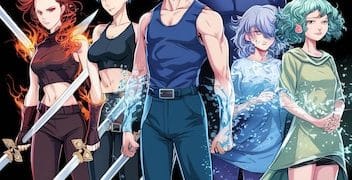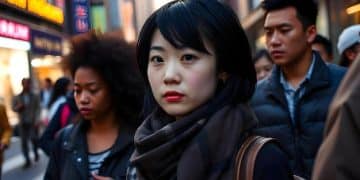Unmasking the Villains: A Psychological Exploration of Antagonists in J-Dramas

Unmasking the Villains: A Psychological Exploration of Antagonists in J-Dramas delves into the complex motivations, character development, and cultural influences that shape villainous characters in Japanese dramas, offering insights into their relatability and societal reflections.
Japanese dramas, or J-dramas, are known for their compelling narratives and diverse characters. While the protagonists often capture our hearts, it’s the antagonists who truly test the boundaries of morality and captivate our attention. Join us as we embark on Unmasking the Villains: A Psychological Exploration of Antagonists in J-Dramas to uncover the intricate layers of these complex characters.
The Allure of the Antagonist
Villains are not simply evil characters. They are often driven by complex motivations, shaped by their past experiences, and influenced by societal factors. Exploring the allure of antagonists in J-dramas allows us to delve into the human psyche and understand the darker aspects of human nature.
Relatability in Villainy
One of the most intriguing aspects of J-drama villains is their relatability. While their actions may be morally reprehensible, their motivations often stem from universal human desires such as love, acceptance, or revenge. This relatability allows viewers to empathize with the villains, even if they don’t condone their actions.
Societal Reflections
J-drama villains often reflect societal issues and anxieties. They may represent corruption, inequality, or the dark side of technological advancement. By exploring these themes through villainous characters, J-dramas offer a critical commentary on contemporary society.
- Complex Motivations: Villains are driven by more than just pure evil; their past experiences shape their actions.
- Societal Commentary: They often represent deeper societal issues, prompting viewers to reflect on real-world problems.
- Challenging Conventions: Villains can subvert narrative expectations and force viewers to question their own moral compass.
Ultimately, the allure of the antagonist lies in their ability to challenge our perceptions of good and evil. They force us to confront uncomfortable truths and question the boundaries of human behavior. By understanding the motivations and complexities of J-drama villains, we gain a deeper understanding of ourselves and the world around us.

Psychological Factors Shaping J-Drama Villains
Several psychological factors contribute to the development of villains in J-dramas. Understanding these factors can shed light on their motivations and explain their actions.
Attachment Theory and Villainy
Attachment theory suggests that early childhood experiences can have a profound impact on an individual’s personality and behavior. Villains in J-dramas often exhibit insecure attachment styles, stemming from neglectful or abusive childhoods. This can lead to feelings of abandonment, insecurity, and a desperate need for control, which may manifest in villainous actions.
Cognitive Distortions
Cognitive distortions are irrational thought patterns that can lead to negative emotions and behaviors. J-drama villains often exhibit cognitive distortions such as catastrophizing, personalization, and black-and-white thinking. These distorted thought patterns can justify their actions and make them feel like they are justified in their villainy.
- Childhood Trauma: Early experiences of abuse or neglect can lead to a desire for control and revenge.
- Insecure Attachment: Feelings of abandonment can drive villains to seek validation through harmful means.
- Distorted Thinking: Irrational thought patterns can justify villainous actions in their own minds.
By examining these psychological factors, we can gain a deeper understanding of the internal struggles that drive J-drama villains. They are not simply evil beings but complex individuals shaped by their experiences and thought patterns, often leading to the rationalization of questionable actions.
Cultural Influences on Antagonist Archetypes in J-Dramas
Japanese culture plays a significant role in shaping the archetypes of antagonists in J-dramas. Values such as honor, duty, and social harmony influence the portrayal of villains and their motivations.
The Conflict Between Tradition and Modernity
Many J-drama villains embody the conflict between traditional Japanese values and the pressures of modernity. They may struggle to reconcile their obligations to family and society with their personal desires, leading to a sense of frustration and resentment. This conflict can manifest in villainous actions as they attempt to assert their individuality or resist societal expectations.
The Importance of “Face” (Mentsu)
In Japanese culture, “face” or “mentsu” refers to an individual’s reputation and social standing. J-drama villains may be driven by a desire to protect their “face” at all costs, even if it means engaging in immoral or illegal activities. Losing “face” can be seen as a devastating blow, leading to desperate measures to regain social standing.
- Honor and Duty: The pressure to maintain social harmony can lead to destructive actions.
- “Face”: Protecting one’s reputation becomes a driving force, justifying immoral behavior.
- Collectivism vs. Individualism: The struggle between societal expectations and personal desires can create conflict.
Understanding these cultural influences provides valuable insight into the motivations and behaviors of J-drama villains. These characters are often driven by a deep-seated need to maintain social harmony and uphold traditional values, even if it means sacrificing their own happiness or engaging in villainous actions.

The Evolution of Villain Archetypes in J-Dramas Over Time
The portrayal of villains in J-dramas has evolved over time, reflecting changes in Japanese society and cultural values. Examining this evolution provides insights into the shifting perceptions of morality and the changing role of antagonists.
From Traditional Villains to Anti-Heroes
In older J-dramas, villains were often portrayed as one-dimensional figures driven by greed or malice. However, modern J-dramas have seen the rise of the anti-hero, a morally ambiguous character who may engage in villainous actions but is driven by a sense of justice or a desire to protect their loved ones. This shift reflects a growing acceptance of moral complexity and a willingness to empathize with characters who operate outside the boundaries of conventional morality.
The Impact of Social Media and Technology
Social media and technology have also influenced the portrayal of villains in J-dramas. Cyberbullying, online harassment, and the spread of misinformation have become common themes, reflecting the growing concerns about the impact of technology on society. Villains may use social media to manipulate and control others, highlighting the dark side of online interactions.
- Moral Ambiguity: Modern villains are often more complex, blurring the lines between good and evil.
- Technological Influence: Social media and technology play a significant role in contemporary villainy.
- Shifting Values: The evolution of villain archetypes reflects changing societal perceptions of morality.
In conclusion, the evolution of villain archetypes in J-dramas mirrors the evolving values and anxieties within Japanese society. From traditional, one-dimensional villains to complex anti-heroes, these characters reflect a growing acceptance of moral ambiguity and a willingness to explore the darker aspects of human nature.
Analyzing Specific Examples of Memorable J-Drama Villains
To further illustrate the psychological and cultural complexities of J-drama villains, it is helpful to analyze specific examples of memorable characters.
The Ruthless CEO: Power and Control
Many J-dramas feature ruthless CEOs who use their power and influence to manipulate and control others. These villains are often driven by a need for validation and a fear of losing control. Their actions may stem from a deep-seated insecurity or a desire to prove their worth. By examining the motivations of these characters, we can gain insight into the corrupting influence of power and the psychological toll of leadership.
The Obsessive Lover: Love and Betrayal
Obsessive lovers are another common archetype in J-dramas. these villains are driven by a desperate need for love and approval. When rejected or betrayed, they may resort to extreme measures, such as stalking, harassment, or even violence. These characters highlight the dark side of romantic obsession and the dangers of unrequited love.
- Power-Hungry Leaders: Driven by insecurity and a need for control, they use their position to manipulate.
- Obsessive Lovers: Rejection fuels their dangerous actions, highlighting the darker side of romance.
- Revenge-Driven Protagonists: Seeking to right perceived wrongs, their actions blur the lines between justice and vengeance.
Each of these examples highlights the diverse motivations and psychological complexities of J-drama villains. These characters are not simply evil beings but complex individuals shaped by their experiences and desires. By analyzing their actions and motivations, we can gain a deeper understanding of the human condition and the darker aspects of human nature.
The Impact of J-Drama Villains on Viewers
J-drama villains have a profound impact on viewers, eliciting a range of emotions and challenging their perceptions of morality.
Emotional Responses and Engagement
Villains evoke a range of emotional responses from viewers, including anger, frustration, fear, and even sympathy. This emotional engagement can enhance the viewing experience and make the drama more memorable. Villains can also serve as a catalyst for discussion and debate, prompting viewers to reflect on the themes and issues explored in the drama.
Challenging Moral Boundaries
J-drama villains often challenge viewers’ moral boundaries by forcing them to confront uncomfortable truths and question their own values. By exploring the complexities of human behavior, these characters can promote critical thinking and encourage viewers to empathize with those who are different from them.
- Provoking Emotional Responses: Villains create a strong emotional connection, making the drama more engaging for viewers.
- Encouraging Empathy: They challenge viewers to understand different perspectives, fostering empathy and understanding.
- Inspiring Reflection: Villains prompt viewers to question their own values and beliefs, promoting critical thinking.
In conclusion, J-drama villains have a significant impact on viewers, eliciting strong emotional responses, challenging moral boundaries, and promoting critical thinking. By understanding the complexities of these characters, we can enhance our appreciation for the art of storytelling and gain a deeper understanding of the human condition.
| Key Point | Brief Description |
|---|---|
| 🎭 Relatability | Villains often share human desires, making them relatable. |
| 🧠 Psychological Factors | Childhood trauma and cognitive distortions shape villains. |
| 🇯🇵 Cultural Influences | Japanese values like “face” influence villainous actions. |
| 🔄 Evolution | Villain archetypes have evolved from simple evil to complex anti-heroes. |
Frequently Asked Questions
▼
Villains in J-dramas are compelling because they often possess intricate backstories and motivations that humanize them, making their actions, even if morally questionable, understandable to the viewers.
▼
J-drama villains frequently embody social issues like corruption or imbalance, prompting critical reflections. By exploring such themes, these characters offer valuable insights into Japanese culture.
▼
Psychological elements like childhood experiences, attachment styles, and cognitive distortions dramatically influence the actions of J-drama villains, making their journeys fascinating to discover.
▼
Villain archetypes have progressed from straightforward figures to morally ambiguous anti-heroes, capturing current society’s complex views on morality. Media and tech influences are ever-present.
▼
Yes, J-drama villains can be relatable because their motivations can stem from feelings like love or the quest for acceptance. This allows viewers to empathize, even in judgment.
Conclusion
Exploring the complex world of antagonists in J-dramas reveals that villainy is not simply about evil deeds. It’s a composite of psychological factors, cultural influences, and societal reflections that shape these characters. By understanding the motivations and complexities of J-drama villains, we gain a deeper understanding of ourselves and the world around us.





